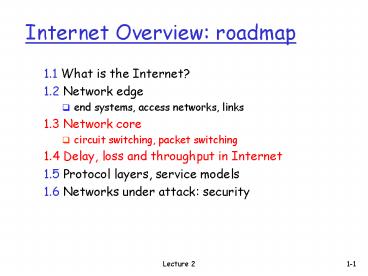Internet Overview: roadmap PowerPoint PPT Presentation
Title: Internet Overview: roadmap
1
Internet Overview roadmap
- 1.1 What is the Internet?
- 1.2 Network edge
- end systems, access networks, links
- 1.3 Network core
- circuit switching, packet switching
- 1.4 Delay, loss and throughput in Internet
- 1.5 Protocol layers, service models
- 1.6 Networks under attack security
2
The Network Core
- Internet mesh of interconnected routers
- How is data transferred through net?
- circuit switching dedicated circuit per call
telephone net - packet-switching data sent thru net in discrete
chunks
3
Network Core Circuit Switching
- End-end resources reserved for call
- dedicated bandwidth resources no sharing
- circuit-like (guaranteed) performance
- call setup required
4
Network Core Circuit Switching
- Total network resources (e.g., bandwidth) divided
into pieces - pieces allocated to each call
- resource piece idle if not used by owning call
(no sharing) - dividing link bandwidth into piecesHOW?
- frequency division multiplexing (FDM)
- Users use different frequency channels
- time division multiplexing (TDM)
- Users use different time slots
5
Circuit Switching FDM and TDM
6
Numerical example 1
- You need to send a file of size 640,000 bits to
your friend. You are using a circuit-switched
network with TDM. Suppose, the circuit-switch
network link has a bit rate of 1.536 Mbps (1Mb
106 bits) and uses TDM with 24 slots. How long
does it take you to send the file to your friend? - Lets work it out!
7
Packet Switching
100 Mb/s Ethernet
C
A
1.5 Mb/s
B
queue of packets waiting for output link
8
Network Core Packet Switching
- each end-end data stream divided into packets
- user A, B packets share network resources
- each packet uses full link bandwidth
- resources used as needed
- resource contention
- aggregate resource demand can exceed amount
available - congestion packets queue, wait for link use
- store and forward packets move one hop at a time
- Node receives complete packet before forwarding
9
Packet switching versus circuit switching
- Packet switching allows users to use the network
dynamically! - resource sharing
- simpler, no call setup
- With excessive users
- Excessive congestion
- packet delay and loss
How do delay and loss occur in Internet/network?
10
How do delay and loss occur?
- packets queue in router buffers
- store and forward packets move one hop at a time
- Router receives complete packet before forwarding
- packets queue, wait for turnDELAY
A
B
11
Four sources of packet delay
- 1. nodal processing
- check bit errors
- determine output link
- 2. queueing
- time waiting at output link for transmission
- depends on congestion level of router
12
Delay in packet-switched networks
- 4. Propagation delay
- d length of physical link
- s propagation speed in medium (2x108 m/sec)
- propagation delay d/s
- 3. Transmission delay
- Rlink bandwidth (bps)
- Lpacket length (bits)
- time to send bits into link L/R
Note s and R are very different quantities!
13
Total delay
- dproc processing delay
- typically a few microsecs or less
- dqueue queuing delay
- depends on congestion
- dtrans transmission delay
- L/R, significant for low-speed links
- dprop propagation delay
- a few microsecs to hundreds of msecs
14
Numerical example 2
L
B
A
R
R
R
- Example A wants to send a packet to B. The
packet size is, L 7.5 Mb (1 Mb 106 bits). The
link speed is, R 1.5 Mbps. How long does it
take to send the packet from A to B? Assume zero
propagation delay. - Lets work it out!
15
Packet loss
- queue (aka buffer) preceding link in buffer has
finite capacity - packet arriving to full queue dropped (aka lost)
- lost packet may be retransmitted by previous
node, by source end system, or not at all
buffer (waiting area)
packet being transmitted
A
B
packet arriving to full buffer is lost
16
Throughput
- throughput rate at which information bits
transferred between sender/receiver
Rs
Rs
Rs
R
Rc
Rc
Rc
17
Numerical example 3 Throughput
- Example A has requested for a packet (size
640,000 bits) from server B. The packet will come
through an intermediate router C. It takes 0.1
second for the packet from B to C and 0.4 seconds
from C to A. (Note 1Mb106 bits). Assume zero
propagation delay. - What is the throughput from B to C?
- What is the throughput from C to A?
- What is the average throughout from B to A?
- Lets work it out!
B
Rs
Rs
Rs
C
Rc
Rc
Rc
A

